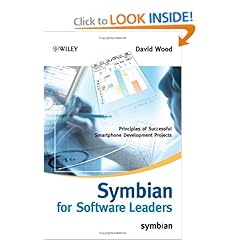 David is certainly qualified for such a book, for example, he thinks the technical lead is the person who:
David is certainly qualified for such a book, for example, he thinks the technical lead is the person who:- Understands how all the technology fits together
- Can deeply analyze individual defects
- Can deeply analyze the pros and cons of various proposed defect fixes
- Understands the technical strengths and weaknesses of all the software engineers who work on the project
I agree 100% with him, so his coverage on s/w management is of less value and interest to me as a pure technical preson so I basically go for the "Part 3 - Symbian's Design Philosophy".
Chapter 15: Design Goals For Symbian OS
Chapter 16: Designing For Efficiency
Chapter 17: Designing For Robustness
Chapter 18: Designing For Usability
Chapter 19: Designing For Longevity
Chapter 20: Designing For Smartphones
As a "Software Architect", David shines here, he is able to explain many of the design decisions first hand at a deep level and in a very clear manner which provides valueble insights of Symbian OS, just give you a taste, here is excerpt from 16.7 Selecting C++:
[ ... However, we remained apprehensive about the sheer size of C++, and thenumber of different programming styles it supported. To constrain programmers, we evolved our own rules for how C++ should be used inside EPOC32:
To avoid design complications, we restricted multiple inheritance to cases in which the second base class is a specially designed ``mixin'' (we were pleasantly surprised to learn that both Taligent and Java imposed similar rules)
As mentioned above, we disabled the compiler's native C++ exception handling
We developed a naming convention that distinguished between classes with and without real destructors
Our rules for templates and inline functions are designed to avoid there being multiple copies of binary versions of the same code in the ROM
We developed custom classes for some very common operations - such as the ``descriptor'' class hierarchy for efficient text string and buffer manipulation.]
Product Description
As a co-founder of Symbian and former executive of Psion Software, David Wood has been actively involved in well over 100 smartphone development projects worldwide. Over the time spent on these projects, he has come to understand the key issues which determine the difference between successful and unsuccessful projects for Symbian OS. This book highlights and explains:
- How to tame the awesome inner complexityof smartphone technology
- Optimal project team organisation, combining agility and reliability
- The design and the philosophy behind key features of Symbian OS
- The potential trouble spots of smartphone integration, testing, and optimisation
- How to receive the full benefit of the diverse skills in the extensive Symbian partner ecosystem
- The methods that are most likely to deliver commercial success when using Symbian OS
- The wider significance of Symbian OS skills and expertise in the evolving mobile marketplace
- The particular importance of software leaders in bringing breakthrough smartphone products to the market
From the Inside Flap
David Wood was a co-founder of Symbian, having joined Psion (Symbian's original parent company) in June 1988. As EVP of Research for Symbian, he is currently responsible for leading a series of collaborative research projects, covering engineering, strategy and market development, focused on improving the competitiveness and value of Symbian's overall offering.
David has an MA in Mathematics from Cambridge University, and has served as Symbian's representative on the Board of Directors for the Open Mobile Alliance. He has been a director of Symbian (and before that, Psion Software) since 1996.
Click Here to see more reviews about: Symbian for Software Leaders: Principles of Successful Smartphone Development Projects (Symbian Press) (Hardcover)
No comments:
Post a Comment